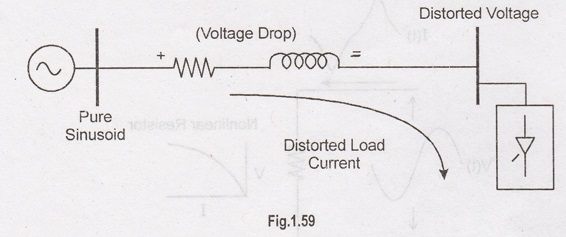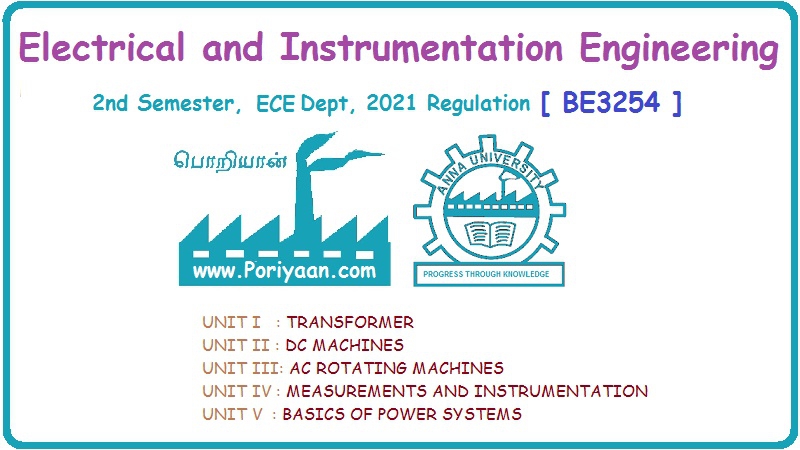Electrical and Instrumentation Engineering: Unit I: Transformer
Harmonics
Transformer
Harmonics are sinusoidal voltages or currents having frequencies that are integer multiples of the frequency at which the supply system is designed to operate (termed the fundamental frequency; usually 50 or 60 Hz).
HARMONICS
Harmonics are
sinusoidal voltages or currents having frequencies that are integer multiples
of the frequency at which the supply system is designed to operate (termed the
fundamental frequency; usually 50 or 60 Hz). 6 Periodically distorted waveforms
can be decomposed into a sum of the fundamental frequency and the harmonics.
Harmonic
distortion originates in the nonlinear characteristics of devices and loads on
the power system.
Harmonic
distortion levels are described by the complete harmonic spectrum with
magnitudes and phase angles of each individual harmonic component. It is also
common to use a single quantity, the total
harmonic distortion (THD), as a measure of the effective value of harmonic
distortion. Figure illustrates the waveform and harmonic spectrum for a typical
adjustable-speed-drive (ASD) input
current. Current distortion levels can be characterized by a THD value, as
previously described, but this can often be misleading.

Adjustable-speed
drives will exhibit high THD values for the input current when they are
operating at very light loads. This is not necessarily a significant concern
because the magnitude of harmonic
current is low, even though its relative distortion is high.
To handle this
concern for characterizing harmonic currents in a consistent fashion, IEEE
Standard 519-1992 defines another term, the total
demand distortion (TDD). This term is the same as the total harmonic
distortion except that the distortion is expressed as a percent of some rated
load current rather than as a percent of the fundamental current magnitude at
the instant of measurement. IEEE Standard 519- 1992 provides guidelines for
harmonic current and voltage distortion levels on distribution and transmission
circuits.
Harmonic Distortion
Harmonic
distortion is caused by nonlinear devices in the power system. A nonlinear
device is one in which the current is not proportional to the applied voltage.
Figure 1.58 illustrates this concept by the case of a sinusoidal voltage
applied to a simple nonlinear resistor in which the voltage and current vary
according to the curve shown. While the applied voltage is perfectly
sinusoidal, the resulting current is distorted. Increasing the voltage by a few
percent may cause the current to double and take on a different wave shape.
This is the source of most harmonic distortion in a power system.

Voltage versus Current Distortion
The word harmonics is often used by itself
without further qualification.
For example, it
is common to hear that an adjustable-speed drive or an induction furnace can't
operate properly because of harmonics. Generally, it could mean one of the
following three things:
1. The harmonic
voltages are too great (the voltage too distorted) for the control to properly
determine firing angles.
2. The harmonic
currents are too great for the capacity of some device in the power supply
system such as a transformer, and the machine must be operated at a lower than
rated power.
3. The harmonic
voltages are too great because the harmonic currents produced to in by the
device are too great for the given system condition.
As suggested by
this list, there are separate causes and effects for voltages and well as some
relationship between them. Thus, the term harmonics by itself is inadequate to
definitively describe a problem.
Nonlinear loads
appear to be sources of harmonic current in shunt with and injecting harmonic
currents into the power system. For nearly all analyses, it is sufficient to
treat these harmonic-producing loads simply as current sources. There are
exceptions to this as will be described later.
As Fig.1.59
shows, voltage distortion is the result of distorted currents passing through
the linear, series impedance of the power delivery system, although, assuming
that the source bus is ultimately a pure sinusoid, there is a nonlinear load
that draws a distorted current. The harmonic currents passing through the
impedance of the system.

Cause a voltage
drop for each harmonic. This results in voltage harmonics appearing at the load
bus. The amount of voltage distortion depends on the impedance and the current.
Assuming the load bus distortion stays within reasonable limits (e.g., less
than 5 percent), the amount of harmonic current produced by the load is
generally constant.
1. The control
over the amount of harmonic current injected into the system takes place at the
end-use application.
2. Assuming the
harmonic current injection is within reasonable limits, the control over the
voltage distortion is exercised by the entity having control over the system
impedance, which is often the utility.
One must be careful when describing harmonic phenomena to understand that there are distinct differences between the causes and effects of harmonic voltages and currents. The use of the term harmonics should be qualified accordingly. By popular convention in the power industry, the majority of times when the term is used by itself to refer to the load apparatus, the speaker is referring to the harmonic currents.
Electrical and Instrumentation Engineering: Unit I: Transformer : Tag: : Transformer - Harmonics
Related Topics
Related Subjects
Electrical and Instrumentation Engineering
BE3254 - 2nd Semester - ECE Dept - 2021 Regulation | 2nd Semester ECE Dept 2021 Regulation
